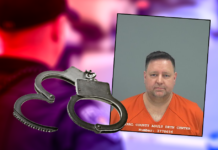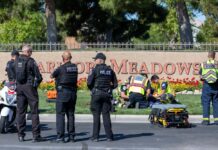Maricopa’s first Getting Arizona Involved in Neighborhoods event Saturday encouraged residents to get to know their neighbors as a preventative measure against crime.
The city’s Block Watch coordinator and captains organized 10 events in neighborhoods throughout Maricopa ranging from small driveway gatherings to a large neighborhood park barbecue.
“I’ve lived here for five years and this is the first time I’ve really interacted with the majority of my neighbors,” said Scott Blevins, a Glennwilde resident.
Cindy Bess, also a Glennwilde resident, said it’s up to neighbors to take action in crime prevention.
“If people realize we’re looking out for each other, they’ll know that they can’t get away with anything,” she said.
The Maricopa police and fire departments, Mayor Christian Price and other councilmembers rotated to each event.
Police Chief Steve Stahl said he wants people to know their public officials are accessible and approachable.
“We want to let them know that we appreciate their involvement in the neighborhoods,” he said. “And see if they have any concerns we might want to address.”
Maricopa Meadows held the largest event with music, food and appearances by public officials. There also were games and competitions, bounce houses and balloons for the kids.
Sarah Brown, a Block Watch captain for Maricopa Meadows, said children are a huge part of bringing the community together and the adults set a good example for them.
“If we stay involved as parents, it’s going to mirror what they need to do, which is to embrace the community,” she said.
Joi-Ashli Gibbs, the Block Watch coordinator, said the captains act as liaisons between residents and public officials.
She also said even though crime is low in Maricopa, it doesn’t mean residents shouldn’t take preventative measures.
“If you start becoming complacent, you’re going to see the crime again,” Gibbs said.
Stahl said face-to-face interaction with neighbors is not a new idea.
“We need to go back to the ‘50s and ‘60s where people knew their neighbors,” he said. “Where people knew their neighbors’ kids, where their neighbors worked and what their work hours were so they could watch out for each other.”


















![Elena Trails releases home renderings An image of one of 56 elevation renderings submitted to Maricopa's planning department for the Elena Trails subdivison. The developer plans to construct 14 different floor plans, with four elevation styles per plan. [City of Maricopa]](https://www.inmaricopa.com/wp-content/uploads/2024/04/city-041724-elena-trails-rendering-100x70.jpg)